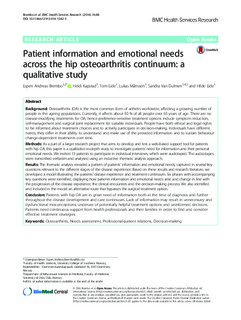| dc.contributor.author | Brembo, Espen Andreas | |
| dc.contributor.author | Kapstad, Heidi | |
| dc.contributor.author | Eide, Tom | |
| dc.contributor.author | Månsson, Lukas | |
| dc.contributor.author | van Dulmen, Sandra | |
| dc.contributor.author | Eide, Hilde | |
| dc.date.accessioned | 2016-07-18T17:15:41Z | |
| dc.date.accessioned | 2016-10-10T13:24:26Z | |
| dc.date.available | 2016-07-18T17:15:41Z | |
| dc.date.available | 2016-10-10T13:24:26Z | |
| dc.date.issued | 2016 | |
| dc.identifier.citation | BMC Health Services Research 2016, 16(1):1-15 | nb_NO |
| dc.identifier.issn | 1472-6963 | |
| dc.identifier.uri | http://hdl.handle.net/11250/2413999 | |
| dc.description | | nb_NO |
| dc.description.abstract | Background:
Osteoarthritis (OA) is the most common form of arthritis worldwide, affecting a growing number of people in the ageing populations. Currently, it affects about 50 % of all people over 65 years of age. There are no disease-modifying treatments for OA; hence preference-sensitive treatment options include symptom reduction, self-management and surgical joint replacement for suitable individuals. People have both ethical and legal rights to be informed about treatment choices and to actively participate in decision-making. Individuals have different needs; they differ in their ability to understand and make use of the provided information and to sustain behaviour change-dependent treatments over time.
Methods:
As a part of a larger research project that aims to develop and test a web-based support tool for patients with hip OA, this paper is a qualitative in-depth study to investigate patients’ need for information and their personal emotional needs. We invited 13 patients to participate in individual interviews, which were audiotaped. The audio-tapes were transcribed verbatim and analysed using an inductive thematic analysis approach.
Results:
The thematic analysis revealed a pattern of patients’ information and emotional needs, captured in several key questions relevant to the different stages of the disease experience. Based on these results and research literature, we developed a model illustrating the patients' disease experience and treatment continuum. Six phases with accompanying key questions were identified, displaying how patients information and emotional needs arise and change in line with the progression of the disease experience, the clinical encounters and the decision-making process. We also identified and included in the model an alternative route that bypasses the surgical treatment option.
Conclusion:
Patients with hip OA are in great need of information both at the time of diagnosis and further throughout the disease development and care continuum. Lack of information may result in unnecessary and dysfunctional misconceptions, underuse of potentially helpful treatment options and uninformed decisions. Patients need continuous support from health professionals and their families in order to find and consider effective treatment strategies. | nb_NO |
| dc.language.iso | eng | nb_NO |
| dc.relation.uri | http://bmchealthservres.biomedcentral.com/articles/10.1186/s12913-016-1342-5 | |
| dc.rights | Navngivelse 3.0 Norge | * |
| dc.rights.uri | http://creativecommons.org/licenses/by/3.0/no/ | * |
| dc.title | Patient information and emotional needs across the hip osteoarthritis continuum: a qualitative study | nb_NO |
| dc.type | Journal article | nb_NO |
| dc.type | Peer reviewed | |
| dc.date.updated | 2016-07-18T17:15:41Z | |
| dc.identifier.doi | 10.1186/s12913-016-1342-5 | |
| dc.identifier.cristin | 1343989 | |

